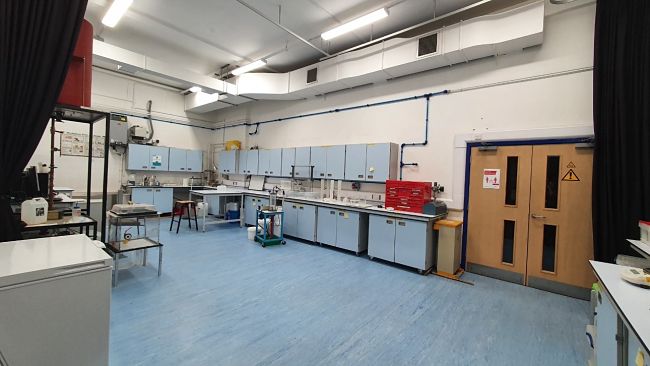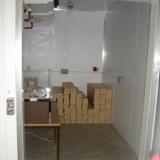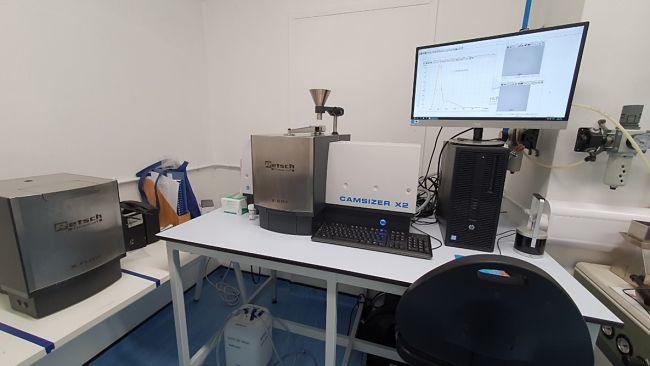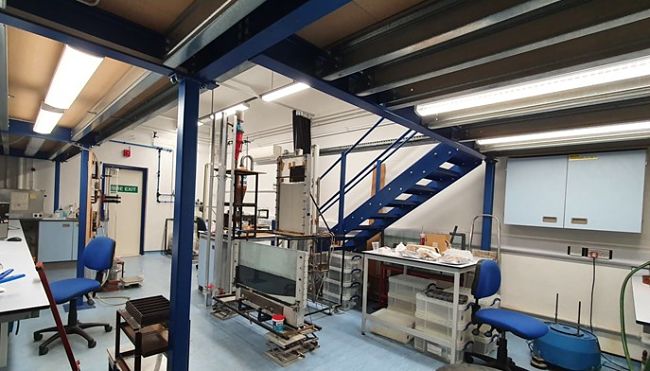Facilities and analytical capabilities
Grain Fluid Dynamics Laboratories G1 and G2
G1 – Wet and Dry Grain Fluid Dynamics
G1 and G1a are multi-use laboratory spaces for experiments with fluids and grains in wet and dry environments, using bespoke apparatus. Equipped with multiple compressed air lines, a walk-in cold room, a sample preparation area with sieves and sieve shaker, an oven and multiple balances.

Equipment available
Aerator

The aerator produces bubble-liquid emulsions. Compressed air is injected into the stream of liquid just before it enters the mixing head. The mixing head comprises a rotor, rotating at an adjustable rate, and a stator which bear interlocking teeth.
Cold room

The cold room is generally set up for sample and core storage at 4°C, but can maintain temperatures of up to -30°C for experiments that require a low temperature environment or for storage of ice cores.
Shock tube apparatus

The shock tube apparatus (including high speed camera) allows the investigation of fragmentation processes of two-phase volcanological flows.
Other equipment
-
- Sieves and Sieve Shaker
- Phantom high-speed camera
- Precision balances covering various weight ranges
- Vacuum pumps
- Cameras – DSLR
- Ph-meter
- Pressure transducers
- Pulse logging (NI Labview)
- Refractometers (Leica, Reichert)
- Thermocouples Lights (Photon Beam, Berkey Beam 800)
- Peristaltic pump
- Ultrasonic bath
- High-Temperature oven
G2 – Rheometry and Particle Characterisation
G2 is a research facility focussing on rheometry and image-analysis based particle characterisation, containing specialist analytical equipment.

Equipment available
HAAKE Mars Rheometer

HAAKE RheoStress 1 Rheometer

The HAAKE MARS and RheoStress 1 rheometers determine various rheological parameters by shearing a test fluid between two surfaces, e.g. between concentric cylinders or between two flat, circular plates. The rheometer measures the torque applied and the rotation rate of the moving cylinder or plate. Established methods exist to convert the observed torque and rotation rate into shear stress and shear strain. Measurements can be either rotational (rotating continuously in the same direction) or oscillatory.
The MARS rheometer includes a combined rheometer-microscope module (RheoScope). This has an integral microscope with a digital video-camera attachment that allows particle motions to be filmed during deformation to be linked to details of the rheological measurement.
VT501 Rotational Viscometer

We have a long-standing relationship with HAAKE. All rheometers in the GFD lab are HAAKE instruments, including the MARS and a RheoStress 1 shown above. Additional to these sophisticated instruments, HAAKE have donated to us a VT501 viscometer. This is a very nice, robust, easy-to-use instrument that we have used mainly for undergraduate teaching. It has also been used in the field (in a porta-cabin in a quarry) to good effect. We are very grateful to HAAKE for this addition to our teaching resources.
Restch CamSizer
The CamSizer uses optical image analysis to measure and characterise particle size and shape. It can be used to assess the grain size distribution in a geological sample, as well as providing additional information (including images) on the morphology of grains. The CamSizer is equipped with a water circulation module (X-Flow) as found in traditional laser diffraction analysers which suspend a sample in a flow cell, as well as the X-Dry and X-Jet modules to allow analysis of larger (more representative) samples and the option of sample recovery after analysis. The X-Jet module can also be used for terminal velocity measurements.

Other equipment
- Stereomicroscope
- Circulators (Haake C40P & K15)
- Precision balance
Field equipment
- 4 spring gravimeters (LaCoste&Romberg, ZLS, Scintrex)
- 4 GNSS receivers (TOPCON and Trimble)
- 1 Theodolite
- UV camera
- FLIR camera
- Sieves for tephra deposits
- Field balance

